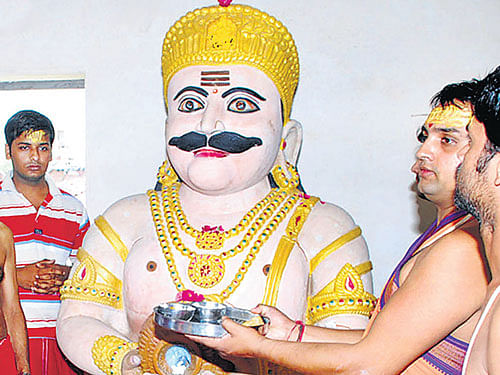
For people across India, demon king Ravana is a symbol of all that is evil. But in a small town in Jodhpur district in Rajasthan, the main antagonist of Hindu epic Ramayana is a much-celebrated figure. Like any other Hindu god and goddess, the demon king has a dedicated temple in Mandore where a cult of Brahmins worship Ravana like a deity.
The Mudgal and Dave Brahmins in Jodhpur believe that they are the descendants of Ravana and respect him for being the “greatest man of all times and father of astrology”. Mandore is also considered as the home town of Ravana’s wife Mandodari and the demon king is treated as the son-in-law among many Brahmin families in the town. While the entire country burns effigies of
Ravana during Dussehra, the descendants and disciples of the demon king perform rituals that are generally associated with death in any Hindu
family.
“Around 700 families of Mudgal and Dave Brahmins in Jodhpur worship Ravana. Most of them claim to be the descendants of Ravana who was a learned scholar and has written several books on medicines, Niti Shastra, Tarka Shastra and many important prayers to appease Lord Shiva. He is also known as the father of astrology,” said Ajay Dave, a priest in Ravana’s temple in Mandore.
“Jai Lankesh Jai Lankesh” and “Ravan Baba Ki Jai” rent the air after the morning prayers in the temple. Ravana’s temple is built on the premises of Mahadev Amarnath and Navgrah temple near Mandore. The temple has a six-foot tall idol of Ravana offering prayers to Lord Shiva. The temple also comprises idols of Shiva and Devi Kharanna.
“Ravana was the biggest devotee of Shiva so his temple remains incomplete without the presence of Shiva. This was the main reason why Ravana’s temple has been built inside the premises of Mahadev Amarnath and Navgrah temple,” said Dave. Prayers are offered to Ravana by chanting Shivatandav Strotra, which was written by the
demon king to appease Shiva, he added.
“Descendants and disciples of Ravana perform 12-day-long death rituals after Dussehra to mourn his death. This 12-day period is called sutak. Separate rituals like shradh and Pinda Daan are performed during that time.
Apart from this, Ravana’s shradh is performed annually on 10th day of 16 lunar days of “Pitra Paksh” that comes a month before Diwali,” said Ajay Dave.
Sutak period
During the sutak period, all disciples and their family members avoid performing religious practices, reading holy books, consuming food with spices, eating sweets, and exchanging gifts. Socially, this custom aims to convey to society that the family is in mourning. The sacred thread Yajnopavitam or Janeu that is worn by all male members in Brahmin families is also changed on the 13th day after Dussehra.
Special astrology classes are held in the temple for students from all Brahmin families. Descendants of Ravana believe that it was their deity who created the science of astrology to predict future on the basis of planetary motion.
“Ravana is believed to have created science of astrology by studying the planetary motion. This is his biggest gift to mankind. He brought together all the planets and compiled them to create astrology. Going by this belief, learning astrology in Ravana’s temple is considered pious among all sects of Brahmins,” said Dave. People not only from Mandore but also from other places come here to learn astrology, he added.
Followers of the demon king believe that Ravana’s temple also saves people from paranormal powers, black magic and all evil spirits. It is believed that the demon king was master of all evil spirits and pious thread given by priest after offering prayers to Ravana keeps all the evil spirits away from an individual.
Presence of Ravana’s devotees in Jodhpur district is linked to several theories which have no documentary evidence. Ravana’s wife Mandodari is considered as one among the five Mahasatis in Hindu mythology. A tall “Chhatri” (umbrella) named “Chavri” still stands in Mandore which is believed to be the wedding spot of Ravana and Mandodari. Most of the followers and descendants of Ravana feel Mandore a safe place to migrate.
“Ravana was a highly learned person and his father was a Brahmin. Many Brahmins from his family came to Mandore with him for his marriage with Mandodari and settled here. According to another theory, his descendants came after Lanka was devastated during the war with Lord Rama. Descendants preferred to travel to Mandore, considering it a safe place because it was the native place of their queen,” said Ajay Dave.
Dave said some descendants migrated to places like Jamnagar, Bhuj and Kutch in Gujarat and other areas of Madhya Pradesh. They are regular visitors to Ravana’s temple. Ravana is also considered as the son-in-law among Namdeo Vaishnav community of Jodhpur while Mudgal Brahmins in Jodhpur consider themselves as descendants of Ravana.
Interestingly, this sect of Brahmins do not exhibit their beliefs and express religious feelings in public. According to them, Ravana’s comparison with other Hindu god and goddess may hurt religious feelings of others and Brahmins.
“He is our deity but we admire him for his good qualities. His death after abducting goddess Sita was destined by God,” said a follower of Ravana.